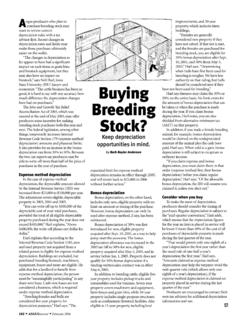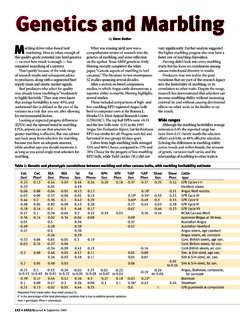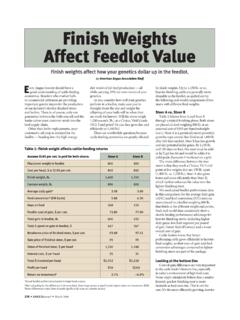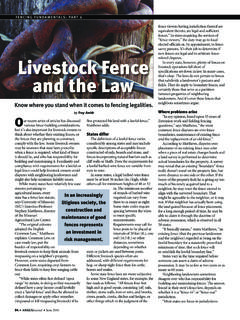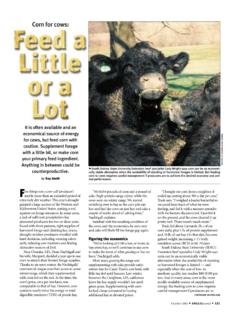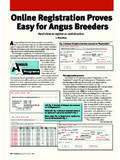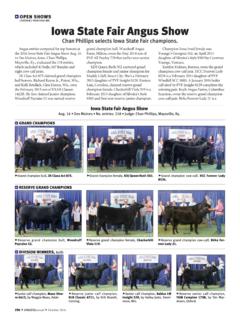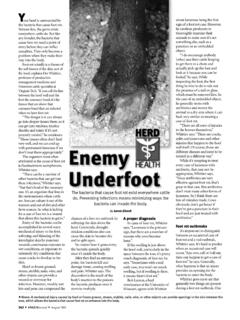Transcription of Building End Braces - Angus Journal
1 Building fence can be hard physical work, but a lot of the sweat is wasted if the fence fails due to poor design and flawed construction technique. And when keeping pasture fence wires tight is chronically difficult, it may be because the end Braces aren t up to snuff. If those critical structures are weak, it s pretty hard to keep fence wires from sagging, no matter how many times they are tightened. Sound end-brace design is based mostly on common sense, seasoned with a pinch of physics and a dash of doesn t take a rocket scientist to realize what s happening when three, four or more strands of fence wire are stretched tightly between two end posts that might be located several hundred feet apart. The pull of the wires will cause the posts to lean toward one another, putting slack in the wires unless the posts are braced against the the most common bracing design is the H-brace, which involves placing a horizontal cross-member between the end post and the next post in the fenceline.
2 Looking at a diagram or an existing brace, it doesn t seem too technical. But if you drive the country roads and really observe, you ll probably see very few H- Braces have been built in a way that optimizes their purpose of an H-brace is to counteract the force of the fence wires pulling on the end post. It s like you re Building something to push back against the force of the wire. The H is formed by placing a cross-member (a wooden pole, beam or length of pipe) between the end post and the second post, at a height approximating 3 4 of the upright post height. The cross-member can be secured into notches cut in the upright posts sort of like a mortise-and-tenon joint. Or pins, such as short pieces of steel rod, can be used to fasten each end of the cross-member to the this point our H-shaped structure isn t much good.
3 The end post now shares its burden with the second post, but both will lean under the pressure of tight fence wires. A key element to the H-brace is the diagonal brace wire actually a long, skinny loop of wire (a double loop is better), fastened around the bottom of the end post and around the second post at the point where cross-member and second post meet. The diagonally placed loop of wire is then twisted tight with a fairly common mistake among novices 66 n AngusJournal n March 2010 FENCING FUNDAMENTALS: PART 2In the second article of this series on Building a good fence, the writer discusses H- Braces , N- Braces and Troy Smith Building End BracesFig. 2: N-braceThis diagram illustrates the alternative N-brace design. The arrow shows the direction of tensionN-brace withdiagonal beamF4F2F1F3 Fig. 1: H-braceThis diagram illustrates an H-brace, showing the triangle created by end post, cross-member and diagonal brace wire.
4 The arrow shows the direction of pull on the tensionF1F2@Fence builders can create a deadman by con-necting a tire, piece of wood or some other cast-off material to a length of light chain or galvanized wire. The bulk can be buried in a low area and the chain or wire tied to the fence wires above to prevent the wires from pulling nearby posts out of the running the diagonal brace wire in the opposite direction (from the top of the end post, down to the bottom of the second post). That will not veteran fence builders who run the brace wire in the right direction often fasten it near the very top of the second post. But securing it at the point of intersection between the cross-member and second post should result in greater strength and durability. Here s where the scientific stuff comes in.
5 Put simply, the strength comes from creating a right triangle with the brace components. The end post and the cross-member make up two sides of the triangle and form its right angle. The diagonal brace wire forms the triangle s opposite side. A physicist can give you the technical reasons why it works. Bottom line: It just works better for making an end post stand up works best if the long side of the triangle (diagonal brace wire) is pretty long, and that requires a long cross-member, too. Long-time fence builders can attest to the fact that H- Braces made with short cross-members don t seem to last very long. According to a rule of thumb that many professionals follow, the length of the cross-member should be at least twice the height of the upright posts. So if the end post and second post stand 4 feet (ft.) tall, make the cross-member of the H-brace at least 8 ft.
6 Another optionGreeley, Colo., fence contractor Clay Nash doesn t use H- Braces , preferring an N-brace design. Instead of placing the cross-member horizontally between end post and second post, it is placed diagonally from the top of the end post to the bottom of the second post. A diagonal brace wire running the other way (making an X with cross-member) is still necessary to hold the brace assembly tightly together. However, Nash says it s the pole or pipe placed diagonally that lends strength to this brace of the design employed, certain brace- Building tips will help ensure strength and longevity. When choosing posts, the general rule is bigger is better. If they don t show excessive rot, used railroad ties may make good posts for constructing Braces . Whether recycled materials or purchased brand new, posts should be long and set deep in the ground.
7 All of my corner posts are at least 8 inches (in.) in diameter. I like used utility poles, cut into lengths of 9 or 10 feet, Nash says. In sandy soil, I ll plant them 5 feet deep. If it s hard ground, 4 feet is probably deep enough. Contractor Dan Sharp, who builds fence within a 100-mile radius of Paris, Mo., prefers big, heavy hedge (Osage orange) posts, with diameters of 8 in. or more. Like Nash, Sharp starts with a deep posthole, and he will use a little cement in the bottom of the hole before tamping in the backfill dirt. The cement adds stability, but it is no substitute for the aboveground brace assembly. Another trick some fence builders use for setting posts firmly in wet ground, is to add a little pea-sized gravel to the backfill dirt. Add backfill a little at a time, tamping as you go to pack it. Then tamp some more.
8 For the diagonal brace wire, I use number nine (nine-gauge) wire wrapped twice around end post and the second post, Sharp states. And you have to twist it until it s tight, but not so much that it breaks. Building good fence starts with constructing Braces , and the fence will be only as good as the Braces a deadmanWhen a fenceline reaches across rough, hilly pastures, it can be hard to keep fence wires tight and secured to posts set in dips, depressions and any low spots between the hills. Over time, the pull of the wires can lift posts out of the ground, particularly if the soil is way some fence builders have remedied this problem is by driving a few big nails partway into a wood post, near its base. Those protruding nails help anchor the post when a little concrete is poured into the bottom of the posthole, prior to alternative method of keeping fence wires at proper height involves the use of a buried anchor or deadman.
9 The deadman, with a length of light chain or galvanized wire attached, is buried in the low area. The end of the chain or wire is left exposed, above ground surface, so it can be tied to the fence wires fence builder can be creative in designing deadmen. Cast-off pieces of iron, like old machinery parts or car wheels, have often been used. Almost anything will work if it s heavy enough that the upward pull of tight fence wires won t work it out of the ground. Some ranchers use pieces of broken fence posts or old tires. Once the bottom half of a tire is filled with dirt or cement and buried, it makes a heavy anchor. FENCING FUNDAMENTALS: PART 2 March 2010 n AngusJournal n 67@This closeup shows how a length of rebar or reinforcement rod was used as a pin to hold the horizontal brace pipe at the desired height.
10 About 4 in. of the rod protrudes from the back-side of the post and inside the pipe. An inch or so of rod protrudes from the post s nearside, and serves to hold the diagonal brace wire.@For this H-brace, a length of steel rod was used as a twitch to twist the diagonal brace wire tight. The twitch was then secured to the horizontal brace pipe to keep the wire from be-coming loose.@Part of new fence going up on the Haumont Ranch near Broken Bow, Neb., this H-brace is constructed of 8-in. posts (8 ft. long) set 4 ft. into the ground. The horizontal brace piece is an 8-ft. length of 31 2-in. salvaged pipe. The diagonal brace wire is 9-gauge galvanized wire wrapped twice around the posts and twisted tight with a twitch.

